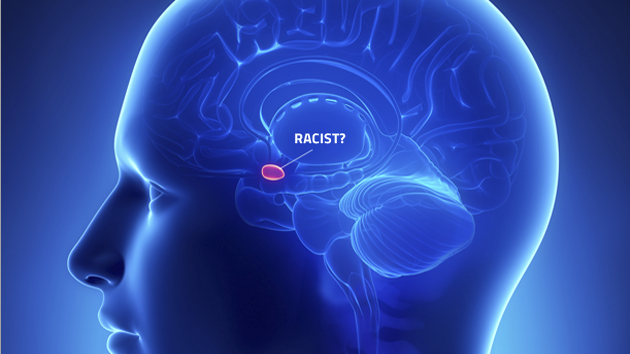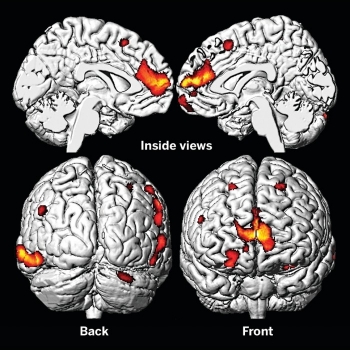
<a href="http://www.shutterstock.com/pic-89261605/stock-photo-a-group-of-animals-are-grouped-together-on-a-white-background-animals-range-from-an-elephant.html?src=GinR7zBvzUtAbxIlX_lBWg-1-22">Angela Waye</a>/Shutterstock
We’ve all been mesmerized by them—those beautiful brain scan images that make us feel like we’re on the cutting edge of scientifically decoding how we think. But as soon as one neuroscience study purports to show which brain region lights up when we are enjoying Coca-Cola, or looking at cute puppies, or thinking we have souls, some other expert claims that “it’s just a correlation,” and you wonder whether researchers will ever get it right.

But there’s another approach to understanding how our minds work. In his new book, The Tale of the Dueling Neurosurgeons, Sam Kean tells the story of a handful of patients whose unique brains—rendered that way by surgical procedures, rare diseases, and unfortunate, freak accidents—taught us much more than any set of colorful scans. Kean recounts some of their unforgettable stories on the latest episode of the Inquiring Minds podcast.
“As I was reading these [case studies] I said, ‘That’s baloney! There’s no way that can possibly be true,'” Kean remembers, referring to one particularly surprising case in which a woman’s brain injury left her unable to recognize and distinguish between different kinds of animals. “But then I looked into it, and I realized that, not only is it true, it actually reveals some important things about how the brain works.”
Here are five patients, from Kean’s book, whose stories transformed neuroscience:
1. The man who could not imagine the future: Kent Cochrane (KC), pictured below, was a ’70s wild child, playing in a rock band, getting into bar fights, and zooming around Toronto on his motorcycle. But in 1981, a motorcycle accident left him without two critical brain structures. Both of his hippocampi, the parts of the brain that allow us to form new long-term memories for facts and events in our lives, were lost. That’s quite different from other amnesiacs, whose damage is either restricted to only one brain hemisphere, or includes large portions of regions outside of the hippocampus.
KC’s case was similar to that of Henry Molaison, another famous amnesiac known as HM. HM taught us that conscious memories of things like which street you grew up on (personal semantic information or facts about yourself) and what happened on your prom night (episodic memories for events in your past) are stored independently from other types of nonconscious memories, of things like how to ride a bike or play the guitar. You can lose one type of memory without losing the other. But KC taught us still more: That our ability to imagine the future is tied to our ability to use our memories to reexperience the past.

“When he lost his past self,” says Kean of KC, “he lost all sense of what he was going to do over the next hour, or over the next day, or over the next year. He couldn’t project himself forward at all, and kind of realize that he would want to be doing something in a month or a year. He was kind of eternally trapped in the present tense.”
Although it might sound obvious now, before KC came along, neuroscientists hadn’t realized how closely tied, on a cognitive level, our future is to our past. “But if you think about it, it does make sense,” explains Kean, “because the ultimate biological purpose of having a memory isn’t just…to make you happy or something like that. The point of a memory is so that you can kind of keep track of what happened in your past, and then apply that to the future.”
2. The man whose vocabulary was reduced to one word: In the late 18th century, the idea that different functions of the mind might be tied to specific parts of the brain first gained a foothold. Phrenology, as it came to be called, was based on the notion that bumps in the skull were markers of larger bits of brain, and that these bumps were clues as to what mental talents, or lack thereof, a person might possess. By the 1840s, however, many scientists dismissed phrenology (and rightly so) as rank pseudoscience.

So when Paul Broca, a French neuroanatomist, first proposed that there was a specific “language area” in the brain—and did so based on evidence from the brain of a patient nicknamed “Tan”—he was laughed out of a scientific meeting.
Tan—whose story is related in Kean’s new book—suffered from epilepsy throughout his childhood. By age 31, he could only respond to questions by repeating the word “tan.” Unless, that is, he was enraged. Then, he’d let out a cry of “Sacre nom de Dieu!” a French insult. Yet Tan still seemed to be able to understand spoken language, even if he could not to speak himself. Because his vocabulary was so impoverished, he became an expert at gesturing, expressing himself through mime.
So how was it possible that a man lost his ability to speak words, but not to understand them?
In 1861, gangrene took Tan’s life—and Broca got his brain, which he proceeded to study. Broca found a lesion on the left side of the brain, near the front. This turned out to be the “language production” node; it is now known as Broca’s area. From Tan and patients like him, neuroscientists thus learned that the speech production and speech comprehension regions of the brain are quite separable—and we need both, functioning properly, to communicate using language.
3. The man whose brain was split in two: In the 1940s, neurosurgeons developed a new procedure to treat patients with severe epilepsy. As a last resort when other less invasive treatments were ineffective, they would sever the major fiber tract, known as the corpus callosum, that connects the two hemispheres of the brain. That way, when the sparks of overexcited neurons started in one part of the brain, the seizure was at least confined to that hemisphere, limiting the damage of the electrical storm.

But as it happened, the patients involved didn’t just have their epilepsy reduced: They also became marvels of science. Because these “split-brain” patients cannot send information from one hemisphere to the other, neuroscientists can learn from them which functions are limited to one side of the brain or the other.
One such patient, with the initials PS, was studied by neuroscientist Michael Gazzaniga. In experiments on PS and other split-brain patients, Gazzaniga devised a clever way of talking to each hemisphere independently. He would flash pictures on different sides of a screen, knowing that the visual system divides the world into two halves, and each hemisphere only sees one of them.
Thus in one experiment, Gazzaniga flashed an image of a snowy scene so that only PS’s right hemisphere would perceive it, and an image of a chicken claw so that only his left hemisphere would pick it up. Then, Gazzaniga asked PS to choose, from an array of objects, those relevant to what he had seen. PS’s left hand (governed by the right hemisphere) picked up a snow shovel, and his right hand (governed by the left hemisphere) chose a rubber chicken. So far, so good: That makes sense.
But when Gazzaniga asked him why he chose those objects, PS responded, “The chicken claw goes with the chicken, and you need a shovel to clean out the chicken shed,” reports Kean. But of course, the shovel actually went with the snow scene. What was happening was that when it came to language, the left hemisphere is dominant. The right hemisphere, by contrast, has a barely functioning language capacity, but can express itself in other ways—by pointing with the left hand, for example, or by drawing or choosing objects with it.
You can watch a video featuring Gazzaniga’s work with another split-brain patient here.
Split-brain patients like PS thus unlocked another mystery of the mind; or rather, the two minds. They showed that the two hemispheres store and process different types of information, and that when the connections between the two hemispheres are broken, each one can act independently of the other. For those of us with an intact corpus callosum, however, the hemispheres share information to such a large extent that calling someone “left-brained” or “right-brained” just doesn’t make sense. “The idea that the left-brain is logical and controls all language, and the right brain is completely arty and just wants to do those kind of creative things—that’s way, way overblown,” says Kean.
4. The woman whose brain forgot animals: This is the story that, when Kean first read about it, he “did not believe it at first.”
“It was a case of someone who had an injury to the part of their temporal lobe,” remembers Kean, “so, on the side of the brain…the temples. And this person lost the ability to recognize all animals.” And yet, stunningly, pretty much everything else was fine.

How could that happen? In his book, Kean explains that the woman in question suffered from complications of a herpes virus infection, which in rare cases can spread to the brain’s temporal lobes, where we store general information about the world, like our knowledge of the capitals of states and countries. When herpes invades the brain, it can induce a coma and even death. But patients who do recover are sometimes left with very bizarre problems: They can lose the ability to recognize a particular category of things.
That’s what happened with the woman who couldn’t recognize animals: She could not tell them apart either by sight or sound, even though she could name and recognize other things just fine—the sound of a doorbell versus that of a phone, for instance. “She knew tomatoes are bigger than peas,” Kean writes, “but couldn’t remember whether goats are taller than raccoons. Along those lines, when scientists sketched out objects that looked like patent-office rejects (e.g., water pitchers with frying-pan handles), she spotted them as fakes. But when they drew polar bears with horse heads and other chimeras, she had no idea whether such things existed.”
These patients have what are called category-specific agnosias, or losses of knowledge. And they have taught neuroscientists something critical concerning how we store information about the world: Namely, our brain divides objects into categories, and organizes those categories hierarchically. Thus, in the patient that Kean describes, the “animal” category had been knocked out, but nothing else had been.
That’s just the beginning of what can happen to the brain, however. There are other patients who suffer from a disease called semantic dementia. First, they can’t tell a robin from a sparrow. Then all birds seem the same. Then, as their brain damage progresses, they can’t tell an animal from an inanimate object—until eventually, their speech contains no specific nouns.
5. The king who kept his skull but lost his mind: If you’re still not convinced that blows to the head can devastate the brain—even if there are no symptoms of concussion, or exterior damage to the skull—this last case just might make you a serious NFL critic. In 1559, King Henry II of France lost a jousting match after taking a blow to the head. In doing so, he proved unequivocally that an intact skull does not mean that an intact brain resides inside it.

At first, the doctors examining the king were not concerned. “They thought Henry was actually going to be just fine because when they looked at his skull, there was no…big crack on the outside; there wasn’t a gory, obvious wound,” says Kean. But it took the dueling neurosurgeons in the title of Kean’s book to realize the extent of the damage to the king’s brain.
“Twisting injuries, where you get hit on the side of your head, and your head kind of jerks one way,” explains Kean, “those are especially bad because they end up tearing the seams between neurons—sometimes even tearing neurons themselves—open. And your brain—because of the flood of chemicals that come out of these torn neurons—your brain often has a big, electrical discharge at the same time.”
“If the brain starts to swell or blood pools up inside the brain, it’s very, very deadly. It will start to crush cells,” Kean says. In such a case, a skull fracture might actually help matters by releasing some of the pressure and limiting the damage.
Henry II was not so lucky: The blow to his head caused his brain to swell and eventually hemorrhage, leading to his death—even though not a single shard of the jousting rod that hit him actually penetrated his brain. Henry’s doctors could not save him, but future researchers learned from his case just how bad brain injuries can be.
Such, then, are some of the fascinating things we can learn from patients whose brains have been altered, or damaged, in unique ways. But as Kean relates, these patients don’t just teach us by virtue of what they have lost. We also have much to learn from what they keep, from the brain functions that still work for them, even after all of their injuries.
Notably, they all seem to keep, at least in some form, their core identities.
“The more cases I looked [at], the more I saw evidence that you really do retain the sense of self,” Kean says. “And in some ways…I thought that was kind of comforting, too, because when you’re talking about these stories, you have to put yourself in the mind of these people, and think, you know, ‘What would I be like if I lost this function of my brain, or, you know, if I turn into a pathological liar or I couldn’t recognize my loved ones anymore?’ But there are some things you do retain, that you won’t lose about yourself.”
To listen to the full interview with Sam Kean, you can stream below:
This episode of Inquiring Minds, a podcast hosted by neuroscientist and musician Indre Viskontas and best-selling author Chris Mooney, also features an exclusive brief interview with Neil deGrasse Tyson about the meaning of the just-completed Cosmos series; a discussion of whether the famed and controversial hormone oxytocin might be capable of extending the span of human life; and a breakdown of the physics of how soccer balls travel through the air (just in time for the World Cup).
To catch future shows right when they are released, subscribe to Inquiring Minds via iTunes or RSS. We are also available on Stitcher and on Swell. You can follow the show on Twitter at @inquiringshow and like us on Facebook. Inquiring Minds was also recently singled out as one of the “Best of 2013” on iTunes—you can learn more here.
















